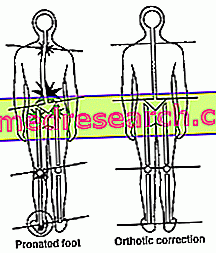Edited by Dr. Francesca Fanolla
The vertebral pains are now "daily bread" for any instructor who sees a "sporting" subject practicing a certain discipline before him, both at amateur and competitive level.

In short we see more closely these athletic gestures attributable to this overload, therefore of future and potential vertebral pains.
ATHLETICS:
- Running (FONDO) the continuous impact of the feet with the ground, often at high intensities, causes disc compressions and relative sciatica with time.
- OBSTACLE STROKE: in addition to the high joint impact in the landing phase that involves the tibio-tarsal and lumbar joints with strong disc compressions, there is also the notable stress on the ileopsoas muscles during repeated flexions and rotations hip. From this may arise lumbosciatalgia from hyperlordosis.
BODY BUILDING
This activity aims almost exclusively at the excessive development of strength and muscle mass resulting in a limitation of muscle elasticity, a reduction of the joint line and an increase in inter-articular pressure with often irreversible problems.
It is therefore advisable, during training, not only to assume the most correct and comfortable posture for the joints but also to compensate for the overload with postural work in muscle stretching (stretching for discharge, relaxation and decompression)
FOOTBALL
Most of the injuries involving the spine in calcium mainly concern the lumbar and cervical sections due to the frequent torsions, flexions and extensions of the trunk, in addition to the intrinsic aspects of the game which are running, changes of direction, jumps, landings that subject all the joints of the lower body in addition to the column to considerable overload and stress.
As far as the cervical tract is concerned, a frequent cervical arthrosis syndrome with cervicobrachialgia and functional limitations has been found, due to the micro-traumas generated by the "head shots".
Strength, flexibility and stabilization training are therefore imperative to protect the spine from these injuries.
CYCLING:
In this discipline the rachis is subjected to very energetic stresses both in a static and dynamic sense and in terms of both size and duration. The static stresses concern the athlete's position on the bicycle maintained for a prolonged time; this prolonged posture leads to an alteration of the physiological curves (accentuation of the dorsal kyphosis and of the cervical lordosis) and to the inversion of the lumbar lordotic curvature.
In these cases you can have:
- osteoarticular low back pain caused by excessive static stresses imposed by the position.
- The constant hyperpressure due to the assumed position that moves the disc backwards, subjecting it to a compression about four times greater than the norm;
- Attitude of hyperlordosis or hypercifosis depending on whether the saddle is too high or too low;
- The effect of cold and humidity in the environment.
The cervical tract is constantly subjected to contractures of the neck extensor muscles, to allow the athlete to look ahead.
It is therefore advisable to get up frequently from the saddle to allow greater relaxation of these muscles and to allow the column to restore its physiological curves.
Furthermore, the intense stress on the knee joint that "gives the push" to the pedaling and, consequently on the intervertebral articular facets of the same side, which discharge all the effort on the lumbosacral area is not to be neglected.
I SWIM:
Swimming has always been considered the "rehabilitative" and "preventive" sport par excellence in cases of vertebral spine diseases as it consists of movements on which no gravity acts, allowing the column to have an active and dynamic rest at the same time.
It also requires non-violent looseness, elasticity and contractions.
BASKETBALL AND VOLLEYBALL
The most frequent injuries are essentially detected in the lower limbs but those related to the vertebral column, especially to the lumbar tract, are not missing.
The main causes are the jumps, then the landing phase which involves considerable vertebral compressions as well as articular "high impact" on the knees and ankles, as well as the frequent and sudden twists to intercept the ball.
A very significant "physical" cause of these injuries is the frequent lack of tonicity and power of the leg muscles (as well as poor elasticity), therefore unable to "absorb" the loads that are inevitably displaced on the aforementioned joints.
Frequent is the lumbosacral stretching of the ligaments or the stretching of the paravertebral, pelvic or flank musculature, whose cause is that of a sudden and rapid rotary movement, often with the appearance of pain during the movement.
The continuous stresses in the jumps and the repeated torsions can also cause the laceration of the fibrous ring and the consequent degeneration of the intervertebral discs leading to discal hernias.
In addition to these pathologies, spondylolysis (sliding of the interarticular part of the vertebra) and spondylolisthesis are often found.
TENNIS
Even in this sport where torsions are frequent, lumbago occurs. Furthermore, the rapid movements, the sudden stops and the continuous torsions of the trunk cause a high and often asymmetrical pressure on the intervertebral discs.
Tennis players therefore need good shoulder mobility and strengthening of the spine, as well as the possibility of playing on soft ground.
TREATMENT
Naturally, anyone suffering from these symptoms and pathologies should absolutely suspend their activity and devote themselves solely to rest, followed by a kinesiological treatment consisting of a work of rehabilitation of the spine that I will discuss in the next article.



